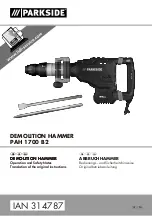
7
• Wire and bristle brushes must never be operated at speeds greater
than 15,000 rpm
and the discharge of the spinning wire brush must be directed away
from the user. Small particles and tiny wire fragments may be discharged at high velocity during
cleaning use with these bristles and become imbedded in your skin. Bristles or wires will be
thrown from the brush at high speeds.
• Wear protective gloves and face shield when using wire or bristle
brushes.
Lightly apply wire or bristle brushes to the work; only the tips of the wires and
bristles do the work. Heavy pressure on bristles overstresses the wire or bristles and will cause
them to be discharged.
• When using grinding wheels or similar attachments,
handle the tool and
wheels carefully to avoid chipping and cracking. If the tool is dropped during use, install a new
grinding wheel. Do not use damaged wheels or wheels that may possibly be damaged. Damaged
wheels may burst during operation causing fragments to fly away high speed possibly striking you
or bystanders causing personal injury.
• Handle sharp bits with care and never use dull or damaged bits
.
Damaged bits may snap during use. Dull bits require applying more force to move the tool,
possibly causing the bit to break.
• Always use clamps or similar devices to secure the work-piece at
all times
. Never hold the work-piece in one hand and the tool in the other to perform work.
Allow sufficient space between your hand and the spinning bit to prevent injury due to “kickback”.
Round work pieces such as dowel rod, pipe, and tubing tend to roll while being cut often causing
the bit to bite into or jump toward you possibly causing personal injury.
• Always inspect the work-piece before cutting
. Cutting irregularly shaped work
pieces may pinch the bit, causing the user to loose their grasp on the tool.
• Never start the tool when the bit is engaged in the work-piece.
The bit
cutting edge may grab the material causing loss of control of the cutter.
• Always use the proper direction of feed when carving, routing or
cutting.
feeding the tool in the wrong direction may cause the bit to climb out of the work-
piece and/or unexpectedly pull the tool in the direction of the feed causing possible loss of tool
control.
• If the bit becomes jammed or bogs down in the work-piece, turn the
tool “OFF” with the switch.
Wait for all moving parts to stop, free the jammed material.
If the switch is left in the “ON” position, the tool could restart unexpectedly causing serious
personal injury.
• Do not leave the tool running unattended!
Only when the tool comes to a
complete stop is it safe to put down.
• Do not grind or sand near flammable materials.
Sparks from the wheel could
these materials to ignite.
• Do not touch the bit or collet after use
, they are too hot to be touched and will
cause burns to bare flesh.
• Do not alter or misuse the tool
. Any alteration or modification is a misuse and may
result in serious personal injury.
• This product is NOT intended for use as a dental drill in human or
veterinary medical applications
. Serious personal injury may result.








































